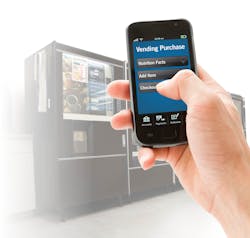Mobile Snapshot – Majority Of U.S. Consumers Have Smartphones, Less Than 1 In 4 Use It For Payments
The Federal Reserve recently released the Consumers and Mobile Financial Services 2015 report, which includes a look at how U.S. Consumers are using Smartphones. More than 70 percent of the U.S. population has a smartphone, but while payment via mobile is increasing, less than a quarter of consumers have used the phone for payment. It is both the ease of paying with cash/credit/debit as well as concerns about security that seem to be holding consumers back.
On the positive side for vending, those that did use smartphones for retail payment were comfortable scanning a barcode, using a QR code or paying via app.
Here is an excerpt of some of the key findings from the Federal Reserve Report:
• Mobile phones are in widespread use.
—87% of the U.S. adult population has a mobile phone, consistent with 2013.
—71% of mobile phones are smartphones (Internet-enabled), up from 61 percent a year earlier.
• Mobile phones are also changing the way consumers make payments.
—22% of all mobile phone owners reported having made a mobile payment in the 12 months prior to the survey, up from 17% in 2013 and 15% in 2012.
—The share of smartphone users who reported having made a mobile payment in the 12 months prior to the survey has increased to 28%, up from 24 percent in both 2013 and 2012.
—Among mobile payment users with smartphones, the most common type of mobile payment was bill payment through an online system or mobile app (68 percent, up from 66%in 2013).
—39% of all mobile payment users with smartphones have made a point-of-sale payment using their mobile phone in the 12 months prior to the survey, in line with the 39% reporting such payments in 2013.
—Of mobile payment users with smartphones who made point-of-sale mobile payments, 31% did so by scanning a barcode or QR code displayed on their phone’s screen at check out (down from 39% in 2013), while 22% used an app that did not require tapping their mobile phone or scanning a barcode (up from 17% in 2013).
—Residents of more rural areas have a lower incidence of mobile payments use than residents of more urban areas.
• A preference for other methods of banking and making payments, as well as concerns about security, continue to be the main impediments to the adoption of mobile financial services cited by some consumers.
—Of those not using mobile banking, the primary reason respondents cited was a belief that their banking needs were being met without the use of mobile banking (86%).
—The primary reason non-mobile payment users gave for not using mobile payments was that they believe it is easier to pay with cash or credit/ debit cards (75%).
—Concern about the security of the technology was a common reason given for not using mobile banking or mobile payments (62% and 59%, respectively, of non-users).





